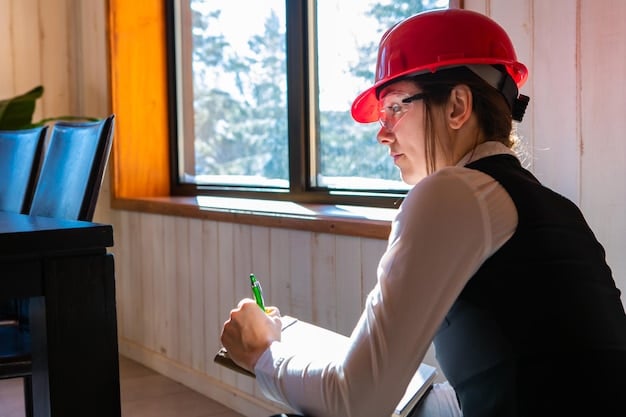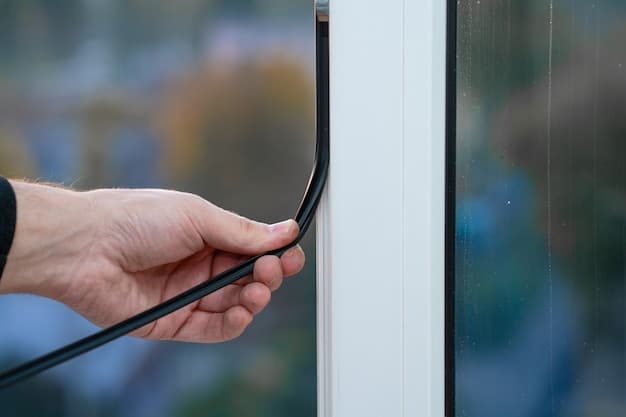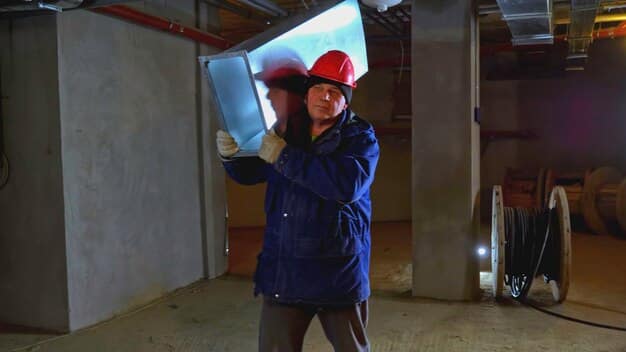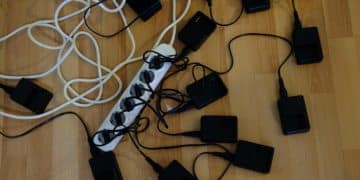Energy Audit Checklist: Find and Fix Hidden Energy Drains This Season

An energy audit checklist allows homeowners to systematically identify and address areas of energy waste, leading to lower utility bills and a more comfortable, energy-efficient home this season.
With the changing seasons comes the perfect opportunity to re-evaluate your energy consumption. An energy audit checklist: identify and fix hidden energy drains this season, is your roadmap to a more efficient and cost-effective home.
Why Conduct an Energy Audit?
An energy audit is more than just a checklist; it’s a comprehensive assessment of your home’s energy efficiency. Understanding why you should conduct one can motivate you to take the necessary steps towards a more sustainable and economical lifestyle.
Save Money on Utility Bills
One of the most compelling reasons for an energy audit is the potential to save money. Discovering and fixing energy leaks can significantly reduce your monthly utility bills. From sealing drafts to upgrading appliances, the long-term savings can be substantial.
Increase Home Comfort
An energy-efficient home is a comfortable home. By addressing issues like poor insulation and leaky windows, you can maintain a consistent temperature throughout your house, making it more enjoyable to live in regardless of the season.
- Identify areas of heat loss in the winter.
- Pinpoint sources of unwanted heat gain in the summer.
- Ensure consistent temperature throughout your home.
Ultimately, conducting energy audits enhance the comfort and livability of your home, contributing to your overall well-being.

Essential Items for Your Energy Audit Checklist
Before you begin your energy audit, it’s essential to gather the right tools and resources. Having these items on hand will make the process smoother and more effective.
Gathering the Right Tools
To conduct a thorough energy audit, you’ll need a few key tools. These items will help you identify areas of energy loss and assess potential improvements.
- A thermal leak detector to pinpoint drafts and insulation gaps.
- A flashlight for inspecting dark corners and attics.
- A measuring tape to assess window and door sizes for weather stripping.
Preparing Your Home for the Audit
Before you start, take some time to prepare your home. This will ensure that you can conduct a more accurate and efficient audit. Compile and have ready your energy bills. You will need these to compare past and future savings, as well as to understand your current usage.
- Gather recent utility bills to compare energy usage.
- Ensure all areas of your home are accessible, including attics and crawl spaces.
- Turn off appliances and lights to get a baseline energy reading.
Preparing your home ensures a more efficient and accurate energy audit process.
Checking Insulation Levels
Proper insulation is one of the most critical components of an energy-efficient home. It helps to keep your house warm in the winter and cool in the summer, reducing the need for excessive heating and cooling.
Attic Insulation
The attic is often the biggest culprit when it comes to heat loss. Proper attic insulation can significantly reduce energy waste. Keep in mind the local climate conditions and your areas energy needs to determine the correct rating of insulation to use.
- Check the depth of your attic insulation to ensure it meets recommended levels.
- Inspect for gaps or areas where insulation is missing or compressed.
- Ensure proper ventilation to prevent moisture buildup.
Wall Insulation
Wall insulation is equally important, especially in older homes. Unlike the attic, it is not always easy to check the wall insulation. Be prepared to drill a small hole or remove an outlet to check the insulation of the wall.
- Use a stud finder to locate wall studs and check for insulation behind them.
- Inspect for drafts around outlets and light switches, which can indicate poor insulation.
- Consider adding insulation to exterior walls during renovations.
Checking and upgrading insulation levels will lead to a more balanced and economical home.

Sealing Drafts and Air Leaks
Drafts and air leaks can significantly impact your home’s energy efficiency. Sealing these leaks is a simple and cost-effective way to reduce energy waste and improve comfort.
Common Sources of Drafts
Identifying the most common sources of drafts is the first step in sealing them. These leaks can occur in various places throughout your home.
- Windows and doors are common culprits.
- Gaps around pipes and wiring.
- Cracks in the foundation or walls.
Effective Sealing Techniques
Once you’ve identified the sources of drafts, you can use several techniques to seal them. From weather stripping to caulk, these methods are relatively easy to implement.
- Apply weather stripping around windows and doors to seal gaps.
- Use caulk to seal cracks and openings in walls and foundations.
- Install foam sealant around pipes and wiring penetrations.
Properly sealing drafts and air leaks contributes directly to energy savings.
Evaluating Your HVAC System
Your heating, ventilation, and air conditioning (HVAC) system is critical for maintaining a comfortable indoor environment. By evaluating its efficiency, you can identify potential areas for improvement.
Assessing System Age and Efficiency
The age and efficiency of your HVAC system play a significant role in energy consumption. Older systems tend to be less efficient and may require more frequent repairs. The average HVAC system is designed for 15 years of use.
Maintenance Tips for Optimal Performance
Regular maintenance is essential for ensuring your HVAC system operates at peak efficiency. Simple tasks can extend its lifespan and reduce energy waste.
- Clean or replace air filters regularly.
- Schedule annual maintenance checks by a professional.
- Ensure proper ventilation around the unit.
By regularly maintaining your HVAC unit, you are helping to ensure that it runs efficiently for the duration of its life.
Checking Appliances and Electronics
Appliances and electronics are significant energy consumers in most homes. By evaluating their efficiency and usage, you can reduce your energy footprint.
Identifying Energy Vampires
Many electronics continue to draw power even when they’re turned off. These “energy vampires” can contribute significantly to your energy bills. Disconnecting devices that are not in use can provide real savings over time.
Choosing Energy-Efficient Appliances
When it’s time to replace appliances, opt for energy-efficient models. Look for the Energy Star label to identify products that meet strict energy efficiency guidelines.
- Refrigerators
- Washing machines
- Dishwashers
Choosing energy-efficient appliances can significantly reduce your energy consumption and lower your utility bills.
| Key Point | Brief Description |
|---|---|
| 💡 Insulation | Ensure adequate insulation in attics and walls. |
| 🌬️ Draft Sealing | Seal air leaks around windows and doors. |
| ⚙️ HVAC System | Maintain and evaluate HVAC system efficiency. |
| 🔌 Appliances | Choose energy-efficient appliances and electronics. |
FAQ
▼
An energy audit is a comprehensive assessment of your home’s energy efficiency, aimed at identifying areas of energy waste and potential improvements.
▼
It’s recommended to perform a basic energy audit at least once a year, ideally before the start of each heating or cooling season.
▼
Key tools include a thermal leak detector, flashlight, measuring tape, and access to your recent utility bills for comparison.
▼
Use weather stripping around windows and doors, apply caulk to seal cracks, and install foam sealant around pipes and wiring penetrations.
▼
Regular maintenance ensures your HVAC system operates efficiently, extends its lifespan, and reduces energy waste.
Conclusion
By following this energy audit checklist: identify and fix hidden energy drains this season, you can take control of your energy usage, reduce your utility bills, and create a more comfortable and sustainable home. Start your audit today to reap the benefits of energy efficiency.





